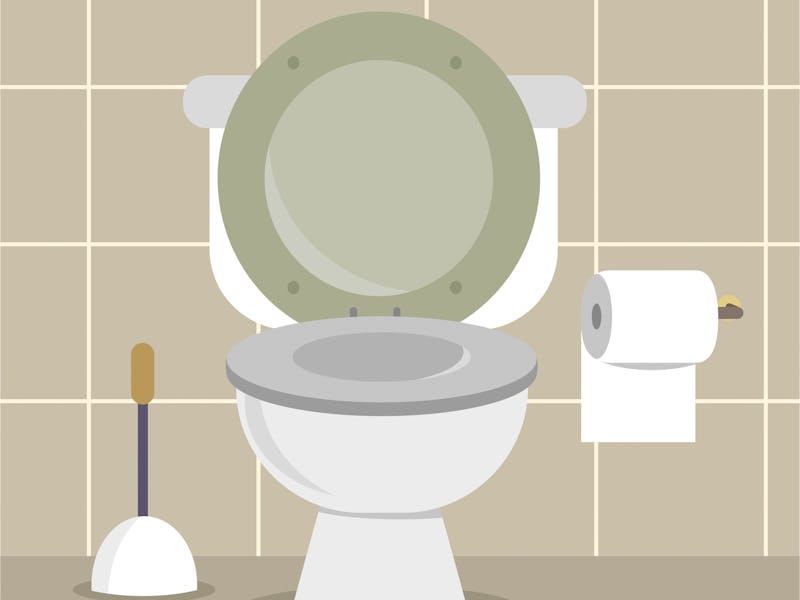This smart toilet wants to film you -- in the name of health!
Bet you didn't think you'd read the word "analprint" today.

Discussing the grisly minutia of your bathroom routine is a taboo held around the world, but a team of Stanford University scientists say it could save your life.
The team has designed a smart toilet equipped with a wide array of bells and whistles designed to continuously collect information about your urine and stool -- including a live video stream and a biometric "analprint" feature. Because these types of samples are routinely used in clinical tests, the researchers say that collecting continuous health data from people's toilets could help identify signs of disease earlier and help users stay on top of their body's health.
In the study, published Monday in the journal Nature Biomedical Engineering, a team of Stanford scientists described their plan for ransacking a commercial-grade bidet toilet attachment and transforming it into the smart toilet of people's dreams (or maybe nightmares.) The toilet is designed to record and analyze several different features of users' excreta using machine vision, pressure sensors, machine learning algorithms, and detachable test strips. These features enable the toilet to conduct uranalysis (which measures the composition of someone's urine), uroflowmetry (which measures the volume or flow rate of someone's urine) and defecation monitoring (which monitors the composition and color of someone's stool.)
While these measures are less physically invasive for users -- the researchers say the toilet is designed to be used normally -- the toilet's thorough monitoring is certainly an of privacy as well as data. And even the safety measures put in place to protect this health data has left users wary, according to the study.
Using cameras positioned around the toilet bowl, the researchers were able to measure information about a users' urine color and flow rate to identify signs of early disease.
To set the scene: you take a seat on your high-tech smart toilet for your morning constitutional. Before you can even begin to leave your sample, the toilet has to first recognize which member of the household is sitting on it. Instead of using one of its many cameras for facial recognition, the team decided to think outside of the box and designed something called an analprint. Exactly what it sounds like, the toilet analyzes the unique creases of the users' anus to recognize whose data it's saving. In their trial, the team found that the toilet was able to successfully differentiate between users with this technique.
But it doesn't stop there -- this toilet has two-factor identification. After being identified by your analprint and finishing your business (during which the toilet uses its cameras to record the first drop of your sample as well as its length and health) the users will then be identified again using fingerprint identification on the toilet's handle.
In addition to using a fingerprint scanner to identify users, this smart toilet also uses the unique creases of a user's anus as a biometric identifier (...yeah.)
When the researchers turned to the Stanford student body for their opinions on this high-tech toilet, the results were mixed. The researchers report that of 300 students surveyed 15 percent were "very comfortable" with the idea of using it and 37 percent were "somewhat comfortable." This leaves at least 30 percent that reported feeling uncomfortable about the idea, most of whom cited the analprint as a major cause of discomfort.
So is the world ready for a toilet this smart? Maybe, but maybe not. As the researchers continue to tweak and improve their design, they hope to reach an iteration that users feel comfortable with because they believe that precision health monitoring like this is essential to a person's overall health.
The smart toilet is equipped with pressure sensors and cameras to recognize when a user is beginning to defecate -- for science.
"Instead of precision medicine, the rapidly evolving field of precision health has expanded efforts in the prevention and early detection of disease through risk-tailored longitudinal monitoring," the authors write. "A similar idea is already realized in the aircraft industry, which implements continuous monitoring of jet engines with hundreds of sensors to prevent engine failure. Unfortunately, in contrast to the aircraft industry, the fact that a normal adult in the United States visits a healthcare provider fewer than four times per year implies that surveillance of the human body is limited, infrequent and possibly insufficient."
But given the unprecedented coronavirus pandemic, who's to say how American views of health will change in the future?
Abstract: Technologies for the longitudinal monitoring of a person’s health are poorly integrated with clinical workflows, and have rarely produced actionable biometric data for healthcare providers. Here, we describe easily deployable hardware and software for the long-term analysis of a user’s excreta through data collection and models of human health. The ‘smart’ toilet, which is self-contained and operates autonomously by leveraging pressure and motion sensors, analyses the user’s urine using a standard- of-care colorimetric assay that traces red–green–blue values from images of urinalysis strips, calculates the flow rate and volume of urine using computer vision as a uroflowmeter, and classifies stool according to the Bristol stool form scale using deep learning, with performance that is comparable to the performance of trained medical personnel. Each user of the toilet is identified through their fingerprint and the distinctive features of their anoderm, and the data are securely stored and analysed in an encrypted cloud server. The toilet may find uses in the screening, diagnosis and longitudinal monitoring of specific patient populations.